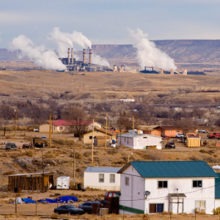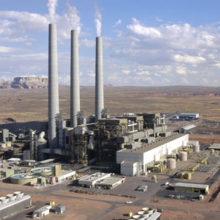After a long history of coal production and energy generation, Montrose County, Colorado, is witnessing a coal transition with the sunset of coal-related industrial activity—possibly in as few as three years.
The closure of the New Horizon coal mine in 2017 and the pending retirement of the Nucla Station coal-fired power plant in 2022 will have implications for the local economy, particularly for local government revenue.
Headwaters Economics prepared two reports that assess the fiscal dependence of local governments in Montrose County on coal revenue as well as Colorado’s fiscal policies which govern the ability for the state and local governments to replace lost revenue. The second report also identifies policy barriers and solutions that affect resource-dependent communities’ ability to build wealth over time and invest in community capacity.
Key findings of the fiscal dependence report include:
• Colorado collects relatively few revenues from coal mining: the state’s effective tax rate on coal is 1.3 percent compared to 9.5 percent and 11.1 percent in Wyoming and Montana, respectively.
• Distributions of state coal severance and federal royalty revenue to local governments in Montrose County totaled more than $1 million as recently as 2015 but declined to less than $300,000 in 2017.
• Local governments in Montrose County rely primarily on property taxes from coal (nearly $2 million annually), with coal power generation making up more than 90 percent and coal mining less than 10 percent.
• The jurisdictions most dependent on coal revenue are the Nucla-Naturita Fire Protection District (coal revenue makes up 56 percent of total governmental revenue from all sources) and the West End Schools (coal revenue makes up 15 percent of total governmental revenue). The Montrose County government is less dependent with coal accounting for only 2 percent of total governmental revenue.
The fiscal policies report lists barriers to transition as:
• State restrictions on local government property tax assessments and levies make it difficult to replace coal revenue after mine or plant closures.
• State restrictions on expenditures and savings limit the autonomy of resource-dependent communities to manage volatile and uncertain revenue sources.
• State school equalization policy that does not fully fund state aid to schools based on hardship-related factors fails to insulate school districts from budget cuts caused by industrial closures.
Recommendations for wealth retention and capacity building include:
• Increase state assistance for transition-related planning and investments, including direct distributions to stabilize local revenue, grants for specific transition investments, and state assistance negotiating with utilities and federal partners.
• Reform state finance rules to allow local governments greater flexibility and autonomy to manage volatile natural resources revenue and budget for long-term transition strategies.
• Create a new permanent fund or endowment for coal-dependent communities at the state or local level, or both.
• Focus on locally-led transition strategies that support and grow local institutions to enhance community capacity.
Coal Transitions and Fiscal Policy
Past fiscal policy decisions that failed to collect and save money from coal extraction–combined with strict limitations on local government’s fiscal autonomy—have exposed local governments in Montrose County to fiscal stress as coal activities come to an end.
Worse, the state and local governments have no savings or dedicated funds to address transition needs or make investments necessary for the future. Addressing these shortfalls will require new revenue and new policy at the state and local level.



